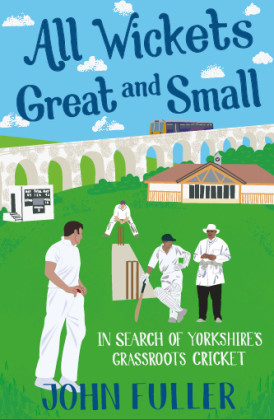All Wickets Great and Small
Martin Chandler |Published: 2016
Pages: 226
Author: Fuller, John
Publisher: Pitch Publishing
Rating: 3.5 stars

I was surprised, pleasantly I hasten to add, to learn from All Wickets Great and Small, that there are around 6,500 clubs affiliated to the England and Wales Cricket Board. That figure in itself is only an indication of the number of people who regularly participate in the game, and I believe the number of clubs is, year on year, declining a little, but it still creates the impression of a healthy game at grass roots level. Yorkshire is, geographically, by some distance the largest county in England and Wales on whatever basis you define ‘county’, but to go on to read that of those 6,500 as many as 10% were in Yorkshire was not what I would have expected. That little stat itself is reason enough to justify the tag of ‘God’s Own County’ that is not infrequently attached to the county of the White Rose.
The ‘plot’ of All Wickets Great and Small surrounds the numerous visits that author John Fuller made to cricket grounds within the Broadacres during the 2015 summer. He couldn’t, of course, hope to visit all of the 600 plus clubs but, if my arithmetic is correct, he manages 35 altogether. On one hectic day around Leeds he got round as many as thirteen on one day, but usually visits were one at a time. The locations involved range from famous clubs that play their home fixtures at county grounds, like the famous North Marine Road in Scarborough, to much more modest sites. The point generally seems to be to see how the clubs are doing in 2015, many of them having been around for generations, and how good or otherwise their futures look. Fuller is certainly the right man to do this and the third chapter of the book in particular contains some sage advice about the use of social media to generate interest. Reading it would be a useful exercise for every single one of the secretaries of every one of those 6,500 clubs.
One of the things that All Wickets Great and Small does to its reader, which is in equal measure frustrating and an indication of how well the author has captured his reader’s interest, is prompt questions. I was left wanting to know more about just about all the clubs that are featured. By way of an example of what I mean one of the clubs Fuller visits is Skipton who play in the Aire-Wharfe League in the north of the county. Clubs in the league are allowed to utilise the services of professionals, but players who have played the First Class game in the preceding five years are not permitted, a rider for which Skipton were responsible. When, in 1991, they employed the former West Indies paceman Winston Davis the rule was introduced. It seems Davis was a bit too sharp for the overwhelming majority of Skipton’s opponents illustrated by his taking 9-16 on debut, but that is all we are told. I will now be scouring the second hand market to find a Skipton club history so that I can establish how the rest of the club’s 1991 summer unfolded.
For those interested in its subject matter All Wickets Great and Small is certainly recommended. It is written in an engaging conversational style, and if the stories of Fuller’s travel arrangements and the quality of the catering he encountered might have worn a little thin on occasions for this reviewer there will doubtless be some for whom it is their favourite feature of the book. In some ways the absence of any photographs might disappoint some. There is a whole book devoted to images of North Marine Road but most of the other grounds featured have never been pictured in any book that I own, and I would like to see them. The publisher would probably point out to me that to reproduce meaningful photographs of the grounds would have demanded a large format coffee table book, and that this is but a slim paperback. It is a fair point, but a few images would not have gone amiss nonetheless.






Leave a comment